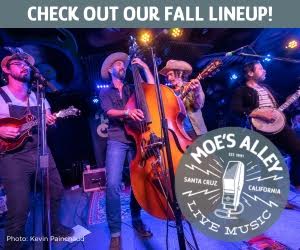 Mavericks competition enters new partnership, shortens season
Mavericks competition enters new partnership, shortens season
It doesn’t look like much at first.
The infamous wave at Mavericks builds slowly—then steepens. All of a sudden, a massive wall of water—sometimes over 50 feet in height—comes crashing down, and you’d better have gotten the heck out of the way.
“It comes out of deep water,” big-wave surfer Darryl “Flea” Virostko says of the wave near Half Moon Bay. “It hits that shallow reef where it’s only 20 feet deep and just folds in half. It drops really critically. It’s a mind-over-matter thing, too. You’ve almost got to just go—not think about too much.”
Since 1999, a massive surf competition has centered around the notoriously fickle wave, which from shore—two miles away—looks like hardly more than a ripple. When conditions have been right, the Mavericks Invitational was on. When big waves never surfaced, neither did the competition. The contest has happened nine of the past 15 years since it began.
Still, the invitational has a following. For the past couple of contests, thousands of people have packed in to watch the show, which these days involves watching surfers charge down massive waves from a parking lot Jumbotron in something of a festival atmosphere.
But the festival element could soon be even bigger. This past summer, Jeff Clark, an unofficial Mavericks gatekeeper who first discovered the wave more than 20 years ago, handed off promotional responsibilities to Cartel Management, a marketing company.
The new name for the event is Titans of Mavericks. Griffin Guess, Cartel’s owner, has said he wants the festival to be “Coachella meets SXSW.” If all goes according to plan, it someday—maybe in 2016—will be a bigger cultural experience, not unlike the X-Games, and have a more lucrative payoff for the surfers too.
“Our goal is to indulge the fans and community with a greater experience all around,” Guess says via email.
Hopefully, it holds up better than the last Mavericks partnership, which was with the marketing company Evolve Sports Management, and ended in a lawsuit.
The relationship between Clark’s camp and Evolve soured when Clark held off on calling the contest in 2009, waiting for ideal waves that never came. Evolve’s Keir Beadling kicked Clark out of the group, and Clark sued for breach of contract and won.
This time around, Clark won’t have any say in calling the contest, but he sits on a committee with Virostko and three other surfers that will help oversee the event. The window for when the event can happen has also been limited from five months to three—January to March. In past years, some of the biggest waves ever to hit Mavericks have come in November and December.
It may sound like a departure from the old Mavericks, but Virostko is excited about what Guess is doing. “Surfers are going to stoked,” he says. And a recent in-depth article in Surfer magazine hinted that although some surfers may scorn the idea, this new direction may be the only way for the contest to survive.
But that still leaves one more question. Come 2016, should the swell crash in, will Cartel really be able to pull off a multi-day festival on relatively short notice? Guess certainly sounds like he’s up to the challenge.
“We live in a time now that festivals can activate on a moment’s notice,” Guess writes. “Most of our nation’s successful events and festivals live by the complexities and speed in being operational on a moment’s notice. Having such a supportive community in Half Moon Bay allows us great opportunity to be prepared. Having production partners and dynamic people at the helm helps us all reach our goal of such a challenging event.”
PHOTO: A surfer is dwarfed by a giant wave at Maverick in 2014. MATT KURVIN












